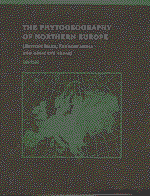Book contents
- Frontmatter
- Contents
- Preface
- Acknowledgements
- 1 Introduction
- 2 Climate
- 3 Edaphic factors
- 4 The geological history of the present European flora
- 5 The atlantic and oceanic elements
- 6 The thermophilic element
- 7 The boreal element
- 8 The arctic, alpine and montane elements
- 9 Endemic, disjunct and centric distribution patterns
- 10 Anthropochorous plants
- Appendix I Calculation of climatic parameters for comparison with plant distributional data
- Appendix II The Northern European species of Flora Europaea with indications of their status and climatic correlations
- Appendix III Arctic species of vascular plants
- Appendix IV Endemic species of vascular plants, bryophytes and lichens
- Appendix V Extra-European disjunctions – bryophytes and lichens
- References
- Index
4 - The geological history of the present European flora
Published online by Cambridge University Press: 23 October 2009
- Frontmatter
- Contents
- Preface
- Acknowledgements
- 1 Introduction
- 2 Climate
- 3 Edaphic factors
- 4 The geological history of the present European flora
- 5 The atlantic and oceanic elements
- 6 The thermophilic element
- 7 The boreal element
- 8 The arctic, alpine and montane elements
- 9 Endemic, disjunct and centric distribution patterns
- 10 Anthropochorous plants
- Appendix I Calculation of climatic parameters for comparison with plant distributional data
- Appendix II The Northern European species of Flora Europaea with indications of their status and climatic correlations
- Appendix III Arctic species of vascular plants
- Appendix IV Endemic species of vascular plants, bryophytes and lichens
- Appendix V Extra-European disjunctions – bryophytes and lichens
- References
- Index
Summary
The late Tertiary
Here a short account will be given of the development of the flora during the late Tertiary period and the environment within which this development took place. This theme has been elaborated in many textbooks and reviews, for example West (1977), Hantke (1978), Nilsson (1982), Birks (1986), Watts (1988) and Tallis (1991).
During the Miocene epoch about 15 million years ago the flora of the Northern Hemisphere including Europe contained a mixture of tropical, subtropical and temperate elements. The tropical elements are now extinct in Europe. Of the subtropical and temperate taxa many are now extinct in Europe, but still some persist in North America, the Caucasus, and eastern Asia, for example Taxodium, Sequoia, Tsuga, Pseudotsuga, Glyptostrobus, Sciadopitys, Ginkgo, Liriodendron, Liquidambar, Nyssa, Pterocarya, Zelkova and Eucommia.
During the following epoch, the Pliocene, the climate gradually became colder. The reason for this might have been the upheaval of mountain massifs in central Asia and western North America affecting the planetary waves, thereby creating conditions for the accumulation of ice and the development of glaciers in the Northern Hemisphere (Ruddiman & Raymo 1988). During this period the tropical elements died out in Europe while several of the subtropical North American and East Asiatic exotics survived. Tsuga, Magnolia, Carya, Pterocarya, Eucommia, Parrotia and Paeonia even survived the earliest glaciations of the following epoch, the Pleistocene.
During the middle and late Pliocene lowlands existed in the present North Sea, probably extending westwards to Scotland, the Faeroes, Iceland and Greenland and northwards to the Voring Plateau southwest of Lofoten, North Norway (Rokoengen & Ronningsland 1983; Eldholm & Thiede 1986a, b).
- Type
- Chapter
- Information
- The Phytogeography of Northern EuropeBritish Isles, Fennoscandia, and Adjacent Areas, pp. 26 - 39Publisher: Cambridge University PressPrint publication year: 1998



